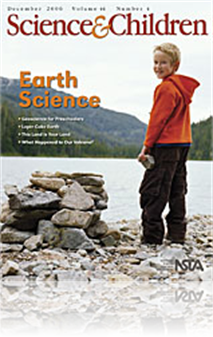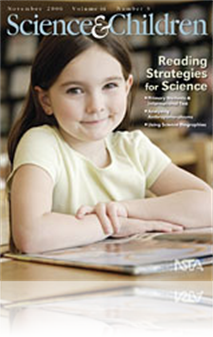All Science and Children resources
Journal Article
Perspectives: On Writing in Science
Many teachers use writing in science as a recording tool (science notebooks) or to find out what students have learned (constructed response tests). Yet writing experts Judith Langer and Arthur Applebee (1987) tell us that writing to evaluate knowled...
Journal Article
The NSTA President's Message: Feedback and Response
In her editorial, “Quality Science Teachers: Essential to America’s Future,” which appeared in the September 2006 issue of several NSTA journals, NSTA President Linda Froschauer wrote passionately about the importance of cultivating the science...
Journal Article
The Early Years: Rocks Tell a Story
Sedimentary rocks, formed by an accumulation of sediments (tiny pieces of rocks or minerals) in a water environment, tell a story that many students may be familiar with. They may have visited areas where water or wind carried sediments and deposited...
Journal Article
The Early Years: Communicating About Collections
Children love to collect all kinds of things, from sticks to colorful leaves to trading cards. These objects are special to children because they found the objects and chose them for a quality determined by them. For preschool students, the quality...
Journal Article
Using Biographies in Science Class
One fifth grade teacher recalls the conversations that took place in grad school regarding the nature of science and science as a human endeavor after her fifth grade students inquired about what a scientist looks like. Students shared descriptions ...
Journal Article
Science 101: Why is Pluto no longer a planet?
On August 24, 2006, the International Astronomical Union (IAU) decided that Pluto was no longer a planet, but rather a "dwarf planet". Our understanding of the solar system has not undergone any radical changes, our understanding of Pluto did not ch...
Journal Article
Teaching Through Trade Books: Moving My Body
The human body is amazing! This month's trade books help students understand their growing bones, muscles, and joints while engaging in some investigations to help them become aware of their bodies and how exercise helps their bodies stay strong....
Journal Article
Primary Students and Informational Texts
Anyone who has spent time looking into science books with young children has no doubt experienced the endless questions that the information and visuals in the books can stimulate. Can snakes climb trees? How do frogs hide from predators? Why do v...
Journal Article
Science Shorts: Seeing is Believing
Many students enjoy the reading about new worlds or imaginary places. The world of microscopy can generate the same kind of excitement and help children rethink the immature idea that only what they see exists. This month's Science Shorts explores ...
Journal Article
As elementary students progress from learning to read toward reading to learn, it is vital that they become strategic readers. A strategic reader is one who understands when and how to use a strategy in order to comprehend text. While some students...
Journal Article
Trade Books for Learning: An Author's View
What other ecosystem is as mysterious and compelling as the rain forest and home to innumerable living things that children may never have seen or heard of before? Answer: mangroves! These fascinating and important habitats are another avenue to te...



